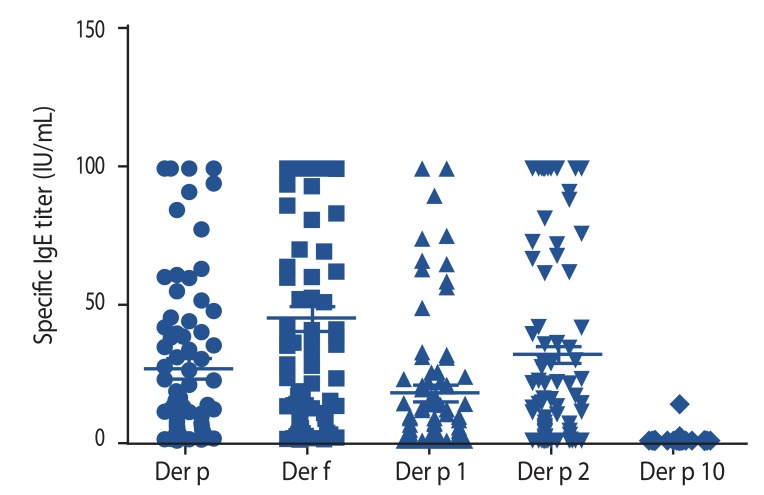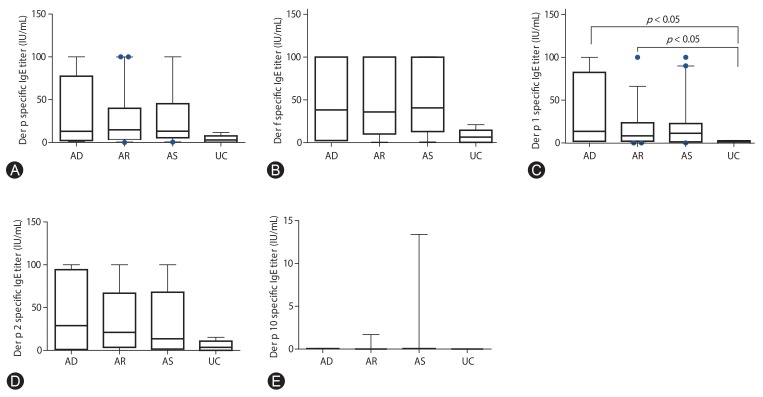Abstract
Background
House dust mites (HDMs) are important sources of indoor allergens. Seventeen components have been identified from Dermatophagoides pteronyssinus (Der p).
Objective
Our aim was to define the prevalence of specific IgE to components of Der p in Korea and investigate the clinical features of them in children with allergic disease.
Methods
We performed a prospective evaluation of 80 HDM sensitized patients with history of allergic rhinitis (AR), atopic dermatitis (AD), asthma and urticaria (UC). Patients underwent ImmunoCAP for total IgE, Der p, Der f, Der p 1, Der p 2, and Der p 10.
Results
Seventy-nine patients had detectable serum IgE to Der p, 80 patients were sensitized to Der f, 66 patients were sensitized to Der p 1, 63 patients to Der p 2, and 7 patients were sensitized to Der p 10. Der p 1 specific IgE was significantly lower in the UC group compared with the AD and AR group. Total IgE was significantly higher in the Der p 10 sensitized group. Der p 10 serum IgE level was highly correlated with crab and shrimp specific IgE. There was a significant positive correlation between total IgE and specific IgE to Der p and its components and Der f.
Conclusion
Sensitization to HDM and its components in Korea is similar to previous studies from temperate climate. The determination of Der p 1, Der p 2, and Der p 10 specific IgE helps in obtaining additional information in regards to allergic disease.
Keywords: Immunoglobulin E; Dermatophagoides pteronyssinus antigen p 1; Dermatophagoides pteronyssinus antigen p 2; der p 10 protein, Dermatophagoides pteronyssinus; Hypersensitivity, Immediate; Child
INTRODUCTION
House dust mites (HDMs) are important sources of indoor allergens [1]. In the general population, the prevalence of HDM sensitization is 9-16% [2]. More than 10 different species have been found in house dust, three of which are very common worldwide-Dermatophagoides pteronyssinus (Der p), Dermatophagoides farinae (Der f), and in tropical climates, Blomia tropicalis [3].
Currently, 17 HDM components have been identified from Der p [4,5] and Der p 1 and Der p 2 are known to be major allergens [6].
Three groups of HDM proteins are currently available for routine laboratory work-up of HDM sensitized patients. Group 1 mite allergens (Der p 1 and Der f 1) are cysteine proteases with multiple effects on mite-host interaction. These proteases facilitate allergen delivery to the submucosa and its antigen-presenting cells, leukocyte recruitment and activation, including mast cell and eosinophil degranulation, bronchial smooth muscle contraction and proliferation [7,8,9,10]. Group 2 mite allergens (Der p 2 and Der f 2) are molecular mimickers of MD-2, a lipopolysaccharide coreceptor for the toll-like receptor-4 [11,12], thus interacting with the innate immune system [4,7,8]. Der p 10 (tropomyosin) is a minor HDM allergen, but its highly homologous counterparts in seafood and snails are well-known inducers of severe systemic anaphylaxis [13,14].
It has been previously shown that serum Ig E to Der p groups 1 and 2 are highly prevalent in HDM allergic patients. While Ig E to Der p 10 is often associated to broader sensitization, such as food [13,15,16]. Still, important variations in Der p 1 (64-100%), Der p 2 (62-91%) and Der p 10 (6-59%) IgE prevalence are reported, which may be accounted for by geographical, age and clinical status-related differences in the study populations [17,18,19,20,21,22].
Our aim was to define the prevalence of IgE to Der p 1, Der p 2, and Der p 10 in Korea and investigate the clinical features of them in children with allergic disease.
MATERIALS AND METHODS
We performed a prospective evaluation of 80 newly diagnosed HDM sensitized allergic patients presenting to the outpatient allergy clinic of the Seoul St. Mary's Hospital in Seoul, Korea between April 2013 and March 2014. The study was approved by the Seoul St. Mary's Hospital Institutional Review Board Committee (protocol No. KC13TISI0511).
Patients
During the study period, 153 children who visited the Allergy Clinic of Seoul St. Mary's Hospital had documentation of clinical criteria sufficient for the diagnosis of atopic dermatitis (AD), allergic rhinitis (AR), asthma (AS), or urticaria (UC). These patients were offered a screening medical examination; in vitro specific IgE measurements against Der p, Der f (ImmunoCAP, Pharmacia Diagnostics AB, Uppsala, Sweden) or MAST OPTIGEN allergy system (Hitachi Chemical Diagnostics, Mountain View, CA, USA). Patient guardians expressed written informed consent and were followed up at the clinic periodically.
MAST OPTIGEN
Patient sera were added to MASTpette chambers which contain 35 kinds of allergens including food and inhalant. After 2 hours of incubation and washes, enzyme-tagged anti-IgE was added. After 2 hours of incubation and washes, luminescent reagent was added. After 10 minutes of incubation, results were interpreted as class 0-4 with MAST OPTIGEN luminometer. Class ≥ 1 was interpreted as positive.
HDM sensitized patients
Patients presented with ≥ 0.35 IU/mL serum levels of IgE to Der p crude extract or Der f crude extract by ImmunoCAP or class ≥ 1 to Der p or Der f by MAST OPTIGEN were defined as sensitized to HDM. As a result, eighty HDM sensitized patients underwent ImmunoCAP for total IgE, Der p, Der f, Der p 1, Der p 2, and Der p 10. Sensitization to Der p, Der f, Der p 1, and Der p 2 were considered significant when specific IgE was >0.35 IU/mL and patients with Der p 10 specific IgE higher than 0.1 IU/mL were considered to be sensitized.
Clinical diagnostic criteria
For the diagnosis of AR: a symptomatic period of minimum 2 months, with at least two of the following: watery rhinorrhea, blocked nose, itchy nose, sneezing, or night cough [23]. For the diagnosis of AD: we used the age appropriate clinical criteria for allergic eczema in childhood, summarized by Muraro et al. [24]. For the diagnosis of AS: a previous diagnosis of AS with proof of reversibility on pulmonary function tests and response to bronchodilators. With younger children or where such evidence was not readily available: a history of three or more episodes of at least two of the following - persistent day time or night time cough, doctor-diagnosed nonfebrile wheezing, recurrent episodes of shortness of breath or exercise-induced shortness of breath or cough. UC defined as a disease characterized by the development of wheals (hives), angioedema, or both [25]. These data were obtained from the clinical records, their clinic interview, and medical examination.
Mite component-specific IgE in serum
Total IgE levels, specific serum Ig E Der p crude extract, Der f crude extract, Der p 1, Der p 2, and Der p 10 were measured with the ImmunoCAP immunofluorimetric assay, components and reagents (Thermo Fisher Scientific, ImmunoDiagnostics, Uppsala, Sweden). Measures of total IgE levels were expressed in international units per unit volume (IU/mL, 1 IU equals 2.4 ng). Specific IgE levels were expressed in arbitrary units per unit volume (IU/mL). The measuring range of total IgE was between 2 and 5,000 IU/mL and that of specific IgE to Der p extract and molecular components was between 0 and 100 IU/mL. In case a measure was too high for the measuring range, we assumed IgE to be 100 IU/mL. The ImmunoCAP 250 machine underwent monthly quality controls (Euro EQAS for Total IgE, Euro EQAS for Specific IgE, Phadia Quality Club for specific IgE).
Statistical analysis
For each patient, levels of total and specific IgE were expressed as previously described. For patient groups, levels of total and specific IgE were expressed as the mean ± standard deviation. Prevalence of Der p, Der f, Der p 1, Der p 2, and Der p 10 sensitizations were expressed with confidence intervals. Comparisons of prevalence in different group were done with Wilcoxson rank sum test for continuous variables. Correlations between total IgE and the antibody responses were analyzed by Spearman rank correlation test. Association between antibody responses and allergic disease were analyzed by chi-square test, Fisher exact test and Wilcoxson rank sum test. All statistical analyses were analyzed using SAS ver. 9.3 (SAS Institute Inc., Cary, NC, USA) and p value of less than 0.05 was considered statistically significant.
RESULTS
During the study period, 153 children who visited the Allergy Clinic of Seoul St. Mary's Hospital had documentation of clinical criteria sufficient for the diagnosis of AR, AD, AS, or UC. Of the 153 patients, 19 patients were sensitized to food allergens and 95 patients were sensitized to aeroallergens. Within the 95 patients sensitized to aeroallergen, 80 were found to be sensitized to HDM and considered to be the study population. The study population consisted of 53 males and the mean age was 9.0 ± 4.3 years (range, 2.0-18.0 years). There was 1 case of AD, 31 cases of AR, 36 cases of AS, 4 cases of UC, 4 cases of AD and AR, 3 cases of AR and AS, and 1 case of AR and UC. Clinical severity was mild to moderate in all patients (Table 1).
Table 1. Patient characteristics (n = 80).
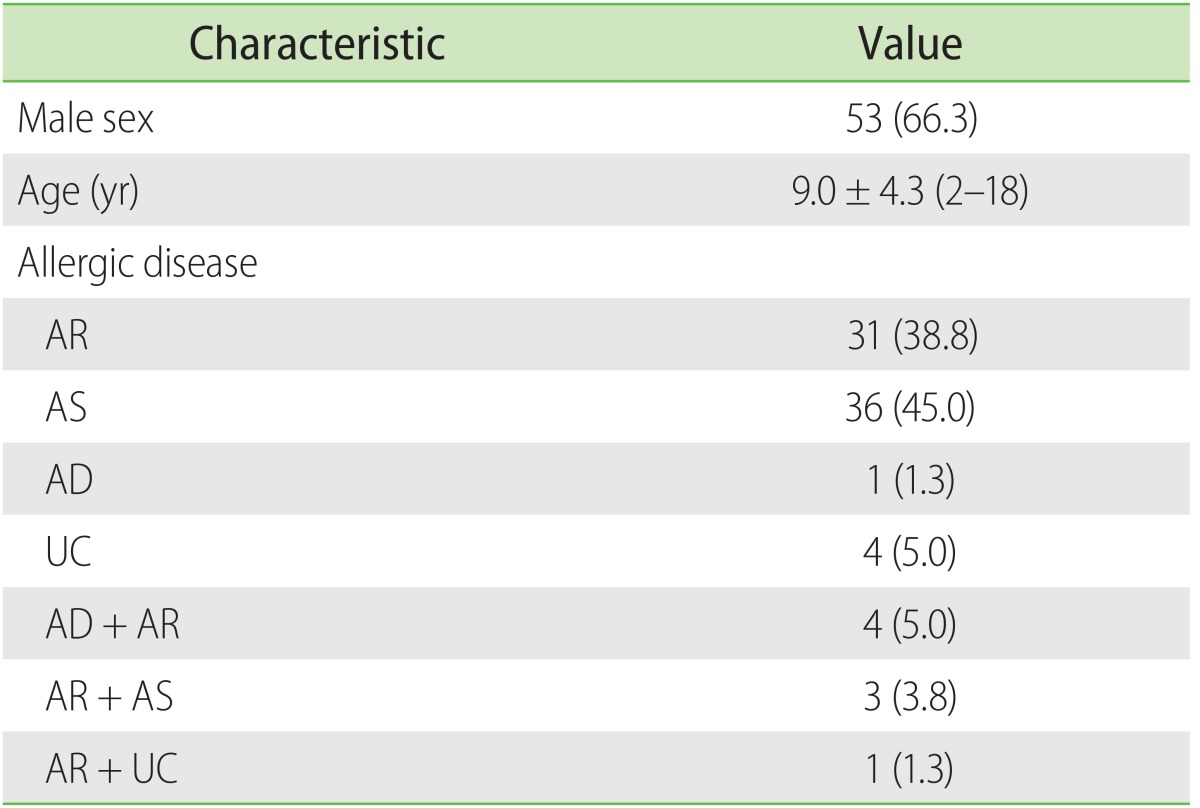
Values are presented as number (%) or mean ± standard deviation (range).
AR, allergic rhinitis; AS, asthma; AD, atopic dermatitis; UC, urticaria.
Prevalence and levels of specific IgE to Der p, Der f, Der p 1, Der p 2, and Der p 10
Seventy-nine patients (98.8%) had detectable serum IgE to Der p, 80 patients (100%) were sensitized to Der f, 66 patients (82.5%) were sensitized to Der p 1, 63 patients (78.8%) to Der p 2, and 7 patients (8.8%) were sensitized to Der p 10 (Fig. 1).
Fig. 1. Specific IgE response to Dermatophagoides pteronyssinus (Der p) allergenic components and Dermatophagoides farinae (Der f).
In respect to allergic disease, IgE reactivity to Der p 1 was significantly lower in the UC group compared with the AD group and the AR group (Fig. 2).
Fig. 2. Specific IgE titer for Dermatophagoides pteronyssinus (Der p) (A), Dermatophagoides farinae (Der f) (B), Der p 1 (C), Der p 2 (D), and Der p 10 (E) according to the allergic disease. AR. allergic rhinitis; AS, asthma; AD, atopic dermatitis; UC, urticaria.
Der p 10 sensitized patients
Seven patients (8.8%) reacted to Der p 10. Six patients were male and their mean age was 7.6 ± 2.9 years. There were 3 cases of AR, 4 cases of AS, 1 case of AD (Table 2). In comparing Der p 10 sensitized group and the rest, total IgE was significantly higher in the Der p 10 sensitized group (p = 0.042) (Table 2). Der p 10 serum IgE level was highly correlated with serum IgE level to crab and shrimp (p < 0.0001 and p < 0.0001, respectively) (Fig. 3). Cockroach showed no correlation with Der p 10 specific IgE (p = 0.670) (Fig. 3).
Table 2. Patient characteristics of Der p 10 sensitized patient (n = 7) in comparison with others (n = 73).
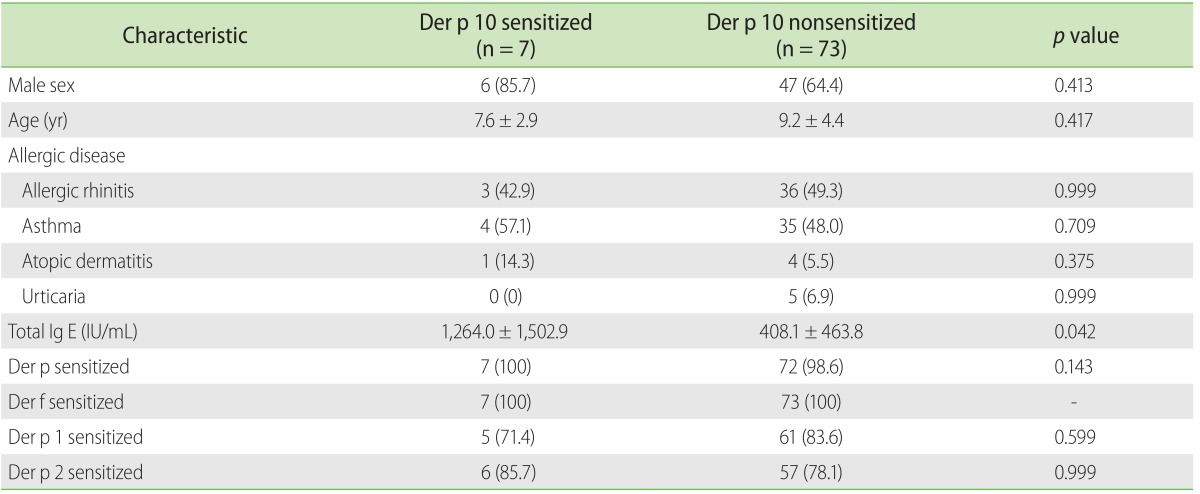
Values are presented as number (%) or mean ± standard deviation.
p value after Bonferroni correction.
Der p, Dermatophagoides pteronyssinus; Der f, Dermatophagoides farinae.
Fig. 3. Correlation between Dermatophagoides pteronyssinus (Der p) 10 specific IgE and specific IgE to shrimp (A), crab (B), and cockroach (C).
Correlation between total IgE and specific IgE to HDM and its components
We found a moderate positive correlation between total IgE and specific IgE to Der p, Der f, Der p 2, and Der p 10 and low positive correlation between total IgE and Der p 1 specific IgE (Table 3).
Table 3. Correlation between total IgE level and housedust mite and its component specific IgE.
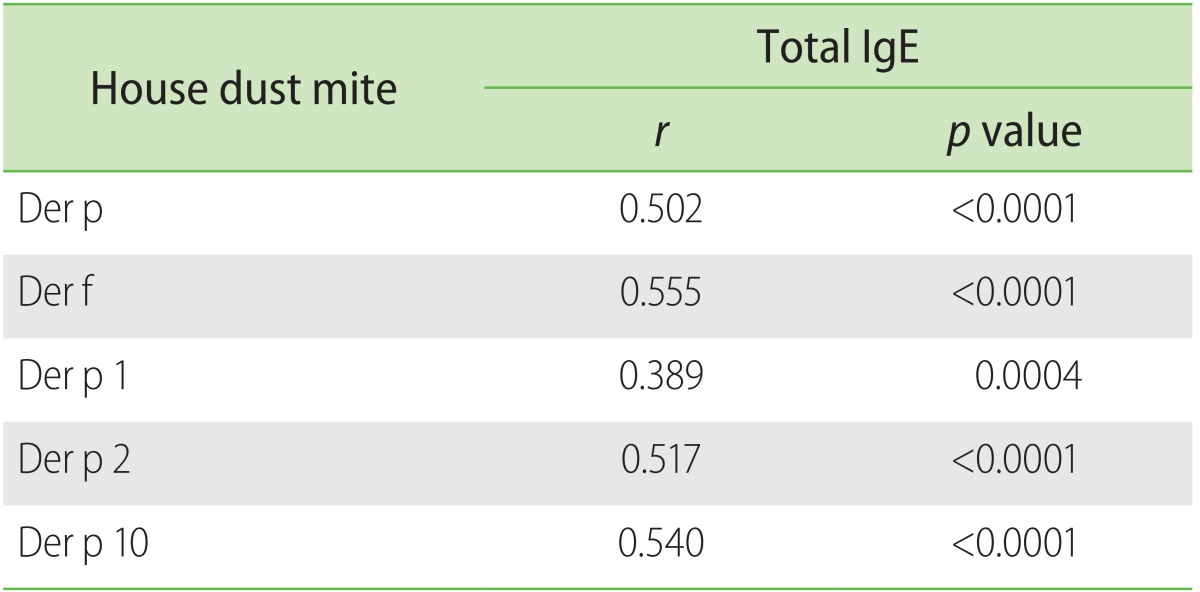
Der p, Dermatophagoides pteronyssinus; Der f, Dermatophagoides farinae.
DISCUSSION
HDM are major allergen sources for almost 50% of allergic patients [26]. In this study, we aimed to define the prevalence of sensitization to Der p 1, Der p 2, and Der p 10 components and investigate the clinical phenotype in allergic children. In our study, the prevalence of sensitization to Der p was 98.8%, Der f was 100%, Der p 1 was 82.5%, Der p 2 was 78.8%, and Der p 10 was 8.8%. Patients with UC had significantly lower IgE titer to Der p 1 than AD and AR. Patients sensitized to Der p 10 showed a significant positive correlation with IgE to crab and shrimp. Total IgE showed significant positive correlation with Der p, Der f, and its components.
Prevalence of HDM sensitization has been studied previously in various climates. According to a study involving French children in 2012, prevalence of Der p 1 sensitization was 95%, Der p 2 was 75%, and Der p 10 was 30% [27]. In another study involving Austrian children and adults, the prevalence of Der p 1 sensitization was 91%, Der p 2 was 86%, and Der p 10 was 6% [17]. Another study conducted in Singapore, which has a tropical climate, reported Der p 1 sensitization prevalence of 64%, 71% showed sensitization to Der p 2, and Der p 10 was sensitized in 4% of the study population [19]. In our study, Der p 1, Der p 2, and Der p 10 sensitization rates were similar to previous studies from temperate climate. The strongpoint of our study lies in the fact that ImmunoCAP was used to determine specific IgE. Previous studies usually used allergen dot immunoblot arrays that are known to be prone to nonspecific IgE binding as well as nonspecific inhibition of IgE binding by the presence of large quantities of antigen specific IgG in patients sera [17,28].
Because Der p 1 and Der p 2 play distinct pathophysiological roles, we hypothesized that sensitization to Der p 1 and Der p 2 specific IgE might influence the clinical phenotype. Therefore we examined for any association between component-specific IgE sensitization with diagnosis of allergic disease. Der p 1 specific IgE titer was significantly lower in the UC group compared with AD group and AR group. This was similar to previous studies which found no particular pattern of component-specific IgE sensitization associated with individual diagnosis of allergic disease, such as AD, AR, and AS [19,27]. However, we found that UC group had significantly lower Der p 1. Further studies involving midrange prevalence molecular components such as Der p 4, Der p 5, and Der p 7 might help clarify the reason for such differences [21].
Der p 10 (tropomyosin) is a minor mite allergen but prominent in seafood, and cross-reactivity is extremely frequent [29]. As expected, in our study, the Der p 10 specific IgE had a significant positive correlation with the specific IgE to shrimp and crab. However, the Der p 10 specific IgE levels showed no correlation with the specific IgE titers to cockroach as previous studies described [30,31]. Our results suggest that high-level Der p 10 IgE reactivity is might be associated with seafood allergy. One possible explanation might come from the high consumption of seafood in Korea, influencing tropomyosin IgE reactivity [31]. Der p 10 sensitized patients had significantly higher total IgE titer compared with Der p 10 nonsensitized group. Further study will be needed to determine its precise significance.
Finally, quantitative data showed a strong correlation between serum levels of total IgE and specific IgE to crude extract of Der p, Der f and its components, Der p 1, Der p 2, and Der p 10. Total IgE was a very good predictor of the levels of Der p, Der f, Der p 1, Der p 2, and Der p 10 IgE levels. Therefore the measurement of serum levels of IgE to Der p 1, Der p 2, or Der p 10 brought little additional information in patients already tested for Der p.
Our study had a few limitations. First, the study was a cross sectional study therefore causal relationship between phenotypic expression and sensitization to HDM and its components were hard to determine. Secondly, the study population was selected from a tertiary hospital located in an inner city environment resulting in selection bias. Finally, we could not perform oral food challenge in children who showed high levels of IgE to shrimp or crab to confirm the diagnosis of food allergy.
In conclusion, sensitization to HDM and its components in Korea is similar to previous studies from temperate climate. The determination of Der p 1, Der p 2, and Der p 10 IgE helps in obtaining additional information in regards to allergic disease. However, cost-benefit aspect should be considered.
ACKNOWLEDGEMENTS
Statistical consultation was supported by Department of Biostatistics of the Catholic Research Coordinating Center.
References
- 1.Spieksma FT, Dieges PH. The history of the finding of the house dust mite. J Allergy Clin Immunol. 2004;113:573–576. doi: 10.1016/j.jaci.2003.10.064. [DOI] [PubMed] [Google Scholar]
- 2.Squillace SP, Sporik RB, Rakes G, Couture N, Lawrence A, Merriam S, Zhang J, Platts-Mills AE. Sensitization to dust mites as a dominant risk factor for asthma among adolescents living in central Virginia. Multiple regression analysis of a population-based study. Am J Respir Crit Care Med. 1997;156:1760–1764. doi: 10.1164/ajrccm.156.6.9704026. [DOI] [PubMed] [Google Scholar]
- 3.Arlian LG, Platts-Mills TA. The biology of dust mites and the remediation of mite allergens in allergic disease. J Allergy Clin Immunol. 2001;107(3 Suppl):S406–S413. doi: 10.1067/mai.2001.113670. [DOI] [PubMed] [Google Scholar]
- 4.Thomas WR, Smith WA, Hales BJ, Mills KL, O'Brien RM. Characterization and immunobiology of house dust mite allergens. Int Arch Allergy Immunol. 2002;129:1–18. doi: 10.1159/000065179. [DOI] [PubMed] [Google Scholar]
- 5.Nomenclature subcommittee [Internet] Kurfürstendamm (DE): International Union of Immunological Societies; c2015. [cited 2014 Jun 7]. Available from: http://www.iuisonline.org/index.php?option=com_content&view=article&id=47&Itemid=54. [Google Scholar]
- 6.Van Der Veen MJ, Jansen HM, Aalberse RC, van der Zee JS. Der p 1 and Der p 2 induce less severe late asthmatic responses than native Dermatophagoides pteronyssinus extract after a similar early asthmatic response. Clin Exp Allergy. 2001;31:705–714. doi: 10.1046/j.1365-2222.2001.01120.x. [DOI] [PubMed] [Google Scholar]
- 7.Gregory LG, Lloyd CM. Orchestrating house dust mite-associated allergy in the lung. Trends Immunol. 2011;32:402–411. doi: 10.1016/j.it.2011.06.006. [DOI] [PMC free article] [PubMed] [Google Scholar]
- 8.Jacquet A. The role of innate immunity activation in house dust mite allergy. Trends Mol Med. 2011;17:604–611. doi: 10.1016/j.molmed.2011.05.014. [DOI] [PubMed] [Google Scholar]
- 9.Lambrecht BN, Hammad H. Biology of lung dendritic cells at the origin of asthma. Immunity. 2009;31:412–424. doi: 10.1016/j.immuni.2009.08.008. [DOI] [PubMed] [Google Scholar]
- 10.Miglino N, Roth M, Tamm M, Borger P. House dust mite extract down-regulates C/EBPα in asthmatic bronchial smooth muscle cells. Eur Respir J. 2011;38:50–58. doi: 10.1183/09031936.00068010. [DOI] [PubMed] [Google Scholar]
- 11.Hongjia L, Qingling G, Meiying L, Weixuan W, Lihong Z, Yongsheng G, Yanli L, Jinxiang W, Liang D. House dust mite regulate the lung inflammation of asthmatic mice through TLR4 pathway in airway epithelial cells. Cell Biochem Funct. 2010;28:597–603. doi: 10.1002/cbf.1697. [DOI] [PubMed] [Google Scholar]
- 12.Trompette A, Divanovic S, Visintin A, Blanchard C, Hegde RS, Madan R, Thorne PS, Wills-Karp M, Gioannini TL, Weiss JP, Karp CL. Allergenicity resulting from functional mimicry of a Toll-like receptor complex protein. Nature. 2009;457:585–588. doi: 10.1038/nature07548. [DOI] [PMC free article] [PubMed] [Google Scholar]
- 13.Resch Y, Weghofer M, Seiberler S, Horak F, Scheiblhofer S, Linhart B, Swoboda I, Thomas WR, Thalhamer J, Valenta R, Vrtala S. Molecular characterization of Der p 10: a diagnostic marker for broad sensitization in house dust mite allergy. Clin Exp Allergy. 2011;41:1468–1477. doi: 10.1111/j.1365-2222.2011.03798.x. [DOI] [PMC free article] [PubMed] [Google Scholar]
- 14.Lopata AL, Lehrer SB. New insights into seafood allergy. Curr Opin Allergy Clin Immunol. 2009;9:270–277. doi: 10.1097/ACI.0b013e32832b3e6f. [DOI] [PubMed] [Google Scholar]
- 15.Reese G, Ayuso R, Lehrer SB. Tropomyosin: an invertebrate pan-allergen. Int Arch Allergy Immunol. 1999;119:247–258. doi: 10.1159/000024201. [DOI] [PubMed] [Google Scholar]
- 16.Jenkins JA, Breiteneder H, Mills EN. Evolutionary distance from human homologs reflects allergenicity of animal food proteins. J Allergy Clin Immunol. 2007;120:1399–1405. doi: 10.1016/j.jaci.2007.08.019. [DOI] [PubMed] [Google Scholar]
- 17.Pittner G, Vrtala S, Thomas WR, Weghofer M, Kundi M, Horak F, Kraft D, Valenta R. Component-resolved diagnosis of house-dust mite allergy with purified natural and recombinant mite allergens. Clin Exp Allergy. 2004;34:597–603. doi: 10.1111/j.1365-2222.2004.1930.x. [DOI] [PubMed] [Google Scholar]
- 18.Weghofer M, Thomas WR, Kronqvist M, Mari A, Purohit A, Pauli G, Horak F, Gronlund H, van Hage M, Valenta R, Vrtala S. Variability of IgE reactivity profiles among European mite allergic patients. Eur J Clin Invest. 2008;38:959–965. doi: 10.1111/j.1365-2362.2008.02048.x. [DOI] [PubMed] [Google Scholar]
- 19.Kidon MI, Chiang WC, Liew WK, Ong TC, Tiong YS, Wong KN, Angus AC, Ong ST, Gao YF, Reginald K, Bi XZ, Shang HS, Chew FT. Mite component-specific IgE repertoire and phenotypes of allergic disease in childhood: the tropical perspective. Pediatr Allergy Immunol. 2011;22:202–210. doi: 10.1111/j.1399-3038.2010.01094.x. [DOI] [PubMed] [Google Scholar]
- 20.Trombone AP, Tobias KR, Ferriani VP, Schuurman J, Aalberse RC, Smith AM, Chapman MD, Arruda LK. Use of a chimeric ELISA to investigate immunoglobulin E antibody responses to Der p 1 and Der p 2 in mite-allergic patients with asthma, wheezing and/or rhinitis. Clin Exp Allergy. 2002;32:1323–1328. doi: 10.1046/j.1365-2745.2002.01455.x. [DOI] [PubMed] [Google Scholar]
- 21.Hales BJ, Martin AC, Pearce LJ, Laing IA, Hayden CM, Goldblatt J, Le Souëf PN, Thomas WR. IgE and IgG anti-house dust mite specificities in allergic disease. J Allergy Clin Immunol. 2006;118:361–367. doi: 10.1016/j.jaci.2006.04.001. [DOI] [PubMed] [Google Scholar]
- 22.Bardini G, Santos AC, Santos KS, Arruda LK. IgE reactivity profiles in patients with asthma and/or rhinitis allergic to cockroach and mites. J Allergy Clin Immunol. 2011;127(2 Suppl):AB171. [Google Scholar]
- 23.Kidon MI, Chiang WC, Liew WK, Lim SH, See Y, Goh A, Tan JP, Chay OM, Balakrishnan A. Sensitization to dust mites in children with allergic rhinitis in Singapore: does it matter if you scratch while you sneeze? Clin Exp Allergy. 2005;35:434–440. doi: 10.1111/j.1365-2222.2005.02208.x. [DOI] [PubMed] [Google Scholar]
- 24.Muraro A, Dreborg S, Halken S, Host A, Niggemann B, Aalberse R, Arshad SH, von Berg A, Carlsen KH, Duschen K, Eigenmann P, Hill D, Jones C, Mellon M, Oldeus G, Oranje A, Pascual C, Prescott S, Sampson H, Svartengren M, Vandenplas Y, Wahn U, Warner JA, Warner JO, Wickman M, Zeiger RS. Dietary prevention of allergic diseases in infants and small children. Part II. Evaluation of methods in allergy prevention studies and sensitization markers. Definitions and diagnostic criteria of allergic diseases. Pediatr Allergy Immunol. 2004;15:196–205. doi: 10.1111/j.1399-3038.2004.00128.x. [DOI] [PubMed] [Google Scholar]
- 25.Zuberbier T, Aberer W, Asero R, Bindslev-Jensen C, Brzoza Z, Canonica GW, Church MK, Ensina LF, Gimenez-Arnau A, Godse K, Gonçalo M, Grattan C, Hebert J, Hide M, Kaplan A, Kapp A, Abdul Latiff AH, Mathelier-Fusade P, Metz M, Nast A, Saini SS, Sánchez-Borges M, Schmid-Grendelmeier P, Simons FE, Staubach P, Sussman G, Toubi E, Vena GA, Wedi B, Zhu XJ, Maurer M European Academy of Allergy and Clinical Immunology; Global Allergy and Asthma European Network; European Dermatology Forum; World Allergy Organization. The EAACI/GA(2) LEN/EDF/WAO Guideline for the definition, classification, diagnosis, and management of urticaria: the 2013 revision and update. Allergy. 2014;69:868–887. doi: 10.1111/all.12313. [DOI] [PubMed] [Google Scholar]
- 26.de Blay F, Pauli G, Velten M, Bessot JC. Influence of mite exposure on symptoms of mite-sensitive patients with asthma. J Allergy Clin Immunol. 1994;93(1 Pt 1):136–138. doi: 10.1016/0091-6749(94)90242-9. [DOI] [PubMed] [Google Scholar]
- 27.Bronnert M, Mancini J, Birnbaum J, Agabriel C, Liabeuf V, Porri F, Cleach I, Fabre A, Deneux I, Grandne V, Grob JJ, Berbis P, Charpin D, Bongrand P, Vitte J. Component-resolved diagnosis with commercially available D. pteronyssinus Der p 1, Der p 2 and Der p 10: relevant markers for house dust mite allergy. Clin Exp Allergy. 2012;42:1406–1415. doi: 10.1111/j.1365-2222.2012.04035.x. [DOI] [PubMed] [Google Scholar]
- 28.Fonseca P, Tavares-Ratado P, Tomaz CT. Interference of Dermatophagoides' specific immunoglobulins G in the quantification of mite's specific immunoglobulins E. J Immunoassay Immunochem. 2009;30:338–347. doi: 10.1080/15321810903084814. [DOI] [PubMed] [Google Scholar]
- 29.Fernandes J, Reshef A, Patton L, Ayuso R, Reese G, Lehrer SB. Immunoglobulin E antibody reactivity to the major shrimp allergen, tropomyosin, in unexposed Orthodox Jews. Clin Exp Allergy. 2003;33:956–961. doi: 10.1046/j.1365-2222.2003.01722.x. [DOI] [PubMed] [Google Scholar]
- 30.Aki T, Kodama T, Fujikawa A, Miura K, Shigeta S, Wada T, Jyo T, Murooka Y, Oka S, Ono K. Immunochemical characterization of recombinant and native tropomyosins as a new allergen from the house dust mite, Dermatophagoides farinae. J Allergy Clin Immunol. 1995;96:74–83. doi: 10.1016/s0091-6749(95)70035-8. [DOI] [PubMed] [Google Scholar]
- 31.Wang J, Calatroni A, Visness CM, Sampson HA. Correlation of specific IgE to shrimp with cockroach and dust mite exposure and sensitization in an inner-city population. J Allergy Clin Immunol. 2011;128:834–837. doi: 10.1016/j.jaci.2011.07.045. [DOI] [PMC free article] [PubMed] [Google Scholar]



